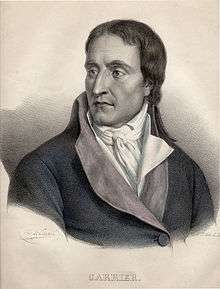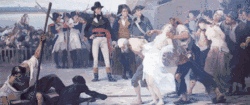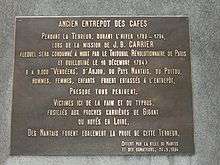Jean-Baptiste Carrier
Jean-Baptiste Carrier (1756 – 16 December 1794) was a French Revolutionary and most notable for his actions during the Reign of Terror in Vendée. While suppressing a Royalist counter-revolution, he commanded the execution of 4,000 civilians, mostly priests, women and children in what Carrier described as "the National Bathtub."[1] After the fall of the Robespierre government, Carrier was tried for war crimes, found guilty and executed.

Biography
Carrier was born at Yolet, a village near Aurillac in Upper Auvergne.[2] As the son of a middle class tenant farmer, Jean-Baptiste Carrier and his family survived on income reaped from cultivating the land of a French nobleman. After attending a Jesuit college in Aurillac, he was able to pursue a wide variety of career interests. Carrier worked in a law office in Paris until 1785 when he returned to Aurillac, marrying, joining the national guard and becoming a member of the Jacobin Club. In 1790 he was a country attorney (counsellor for the bailliage of Aurillac) and in 1792 became deputy to the National Convention. He was already known as one of the influential members of the Cordeliers club and of the Jacobin Club.

After the subjugation of Flanders he was one of the commissioners nominated in the close of 1792 by the Convention. He voted for the execution of King Louis XVI of France, was one of the first to call for the arrest of the Duke of Orléans, and took a prominent part in the overthrow of the Girondists (on 31 May).
Representative to Nantes


After a mission to Normandy, Carrier was sent, early in October 1793, to Nantes, under orders from the National Convention to suppress the revolt of anti-revolutionists. He established a revolutionary tribunal in Nantes and formed what was called the Legion of Marat, to dispose quickly of the masses of prisoners heaped in the jails. The trial were soon discontinued, and the victims were sent to the guillotine, shot, or disposed of in a more inhumane way.
In a twenty-page letter to his fellow republicans, Carrier promised not to leave a single counter-revolutionary or monopolist (in reference to hoarders and aristocratic land owners) at large in Nantes.[3] His vigorous action was endorsed by the Committee of Public Safety, and in the following days Carrier put large numbers of prisoners aboard vessels with trap doors for bottoms, and sunk them in the Loire river.[4] These executions, especially of priests and nuns, as well as women and children, known as the Drownings at Nantes (Noyades), along with his increasing demeanor, gained Carrier a reputation for wanton cruelty. Some alleged that he ordered young male and female prisoners be tied together naked before the drownings, a method which was called a "Republican marriage", but this accusation was later found to be a rumor started by counter-revolutionaries.[5][6]
He was described by Thiers as being "...one of those inferior and violent spirits, who in the excitement of civil wars become monsters of cruelty and extravagance."[7] He also organised the ransack of public storehouses, mills, and bake houses in an effort to find "military" resistance evidenced in hidden weapons, artillery, and gunpowder. Finding little contraband, he nevertheless burned down buildings of every kind in what he identified as "revolting districts."
Trial and conviction
Early in 1794 Carrier was recalled to Paris.[8] A few months later, the Thermidorian reaction led to the fall of Robespierre and the Committee of Public Safety. Carrier's position became dangerously exposed. Prisoners he had brought from Nantes were acquitted and released, and denunciations of Carrier's actions increased. On 3 September 1794 Carrier was arrested. At his trial, in the Salle de la Liberté, Carrier was quick to denounce allegations of inhumanity saying, "I took but little share in the policing of Nantes; I was only there in passing, being first at Rennes and later with the army. My principal task was to watch over and see to the victualling of our troops, and for six months I supplied 200,000 men there without its costing the State a halfpenny. Hence I have little information to offer in the matter. I know little or nothing of the accused."[9] After this statement, a fellow representative (Phélippes) sprang to his feet vocally charging Carrier with drownings, wholesale executions, demolitions, thefts, pillaging, laying waste to Nantes, famine and disorder, and with the butchering of women and children. Men from the Marat Company (the group of soldiers that Carrier used to purge Nantes) were present during the trial, including Perro-Chaux, Lévêque, Bollogniel, Grandmaison, and Mainguet. All these men were appointed directly and indirectly by Carrier and all were part of the Revolutionary Committee of Nantes. The jury that heard Carrier's case was left dumbfounded as the trial closed and passed a unanimous vote for Carrier's execution, which took place on 16 December 1794.[10]
See Comte Fleury, Carrier à Nantes, 1793–1794 (Paris, 1897); Alfred Lallié, J. B. Carrier, représentant du Cantal à la Convention 1756–1794 d'après de nouveaux documents (Paris, 1901).
References
- Loomis, Stanley (1964). Paris in the Terror. Philadelphia; New York: J.B. Lippincott Co. p. 289. OCLC 401403.
- Chronicle of the French Revolution, Longman Group 1989 p.30
- Christopher Desloge, Desloge Chronicles - A Tale of Two Continents, Lulu.com, 2013 p.13
- Chronicle of the French Revolution, Longman Group 1989 p.390
- Bertrand, Ernest. 1868. La justice révolutionnaire en France du 17 août 1792 au 12 prairial an III (31 mai 1793), 17:e article, Annuaire de la Société philotechnique, 1868, tome 30, p. 7-92.
- Alain Gérard (1993). La Vendée: 1789–1793. p.265-266
- Thiers, Adolphe and Frederic Shoberl, The History of the French Revolution. Vol. 3. New York: D. Appleton & Co, 1866 p.66
- Chronicle of the French Revolution, Longman Group 1989 p.407
- Lenotre, G. Tragic Episodes of the French Revolution in Brittany, With Unpublished Documents. Trans. H. Havelock. London: David Nutt, 1912 p.307
- Chronicle of the French Revolution, Longman Group 1989 p.462
Bibliography
- Carrier, Jean-Baptiste, Correspondence of Jean-Baptiste Carrier: people's representative to the Convention during his mission in Brittany, 1793-1794, Nantes: John Lane Company, 1920, Google Books, downloadable eBook.
- Hanson, Paul R. Historical Dictionary of the French Revolution. France: Scarecrow Press, 2004.
- Joes, Anthony James. Guerilla Conflict before the cold war. Westport: Greenwood Publishing Group, 1996.
- Lenotre, G. The French Revolution in Brittany. Edinburgh: Ballantyne, Hanson & Co, 1912.
- Lenotre, G. Tragic Episodes of the French Revolution in Brittany, With Unpublished Documents. Trans. H. Havelock. London: David Nutt, 1912.
- Stephens, Henry Morse. A History of the French Revolution. Vol. 3. New York: Charles Scribners & Sons, 1891.
- Thiers, Adolphe and Frederic Shoberl. The History of the French Revolution. Vol. 3. New York: D. Appleton & Co, 1866.
- Webster, Noah. Webster's New Universal Unabridged Dictionary. Vol. 2. New York: Simon & Schuster, 1983.
